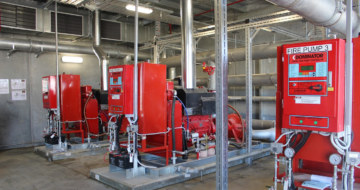
February 12, 2020 in Our Experience
Goulburn Valley Health
A state-of-the-art redevelopment of Goulburn Valley Health in Shepparton will deliver new and expanded healthcare facilities to meet the growing commu...
June 7, 2016
Modern fire protection systems are now often integrated into other building systems and require a comprehensive testing approach to assure they will operate when required.
In the past, fire protection systems in buildings were relatively straightforward and generally operated independently of other systems. Over the last 10 years, due mainly to the introduction of performance based solutions, these systems have become increasingly integrated with other building systems, especially air conditioning and ventilation systems.
While system integration can have significant benefits, it usually results in more complex systems that have a higher susceptibility to failure. Additionally, the failure of highly integrated system can have the potential to escalate the impact of a fire. For instance, an air conditioning system operating incorrectly in fire mode may actively spread smoke throughout a building.
Another issue with integrated systems is that they can be very challenging and time consuming to test and maintain to the level required to provide a high degree of surety of operation and adequately discharge duty of care obligations.
In responding to this change, installation and maintenance standards have had an increasing focus on integrated fire mode testing.
However it is important to understand the extent of testing required by these standards and the level of integrated systems surety it provides:
Complex integrated systems need a clear framework for testing.
Integrated Fire Mode Testing (IFMT) is a comprehensive approach to the testing of integrated systems and involves the operational testing of the functional interfaces between systems in fire mode.
Undertaken in conjunction with, or in addition to, individual system commissioning and testing IFMT will confirm that the integrated systems operate together as intended.
A key aspect when considering IFMT is determining the extent of testing needed to achieve the required level of operational surety. Idyllically, each input device in the entire integrated system would be initiated and the operation of each output or response would be confirmed. But regularly conducting such detailed testing would result in impractical timeframes and unaffordable costs. Alternatively, simple tests that verify minimal high level interfaces may not be adequate to address duty of care concerns.
The appropriate level of testing to suit the installed systems and operational requirements must be determined for a particular facility. This may include testing a number of detection Alarm Zones and confirming operation of individual items of Equipment.
The key to a successful IFMT approach is a well documented interface cause and effect matrix; usually called an Integrated Fire Mode Matrix.
This is particularly important in buildings with performance based ‘fire engineered’ solutions where non typical interfaces are present that are not well covered by generic standards. If a complete and accurate Fire Mode Matrix is not available this should be developed by an appropriately qualified and experienced fire services specialist.
This matrix assists in addressing the building’s prescribed essential safety measures by defining the basis of the testing regime, the appropriate scope and extent of testing, and how correct operation is to be verified. The matrix also provides insights into coordination between systems specialists. A detailed test plan should be documented to assure the operation of integrated fire systems and address duty of care requirements.
For more information please contact us.
download pdf
February 12, 2020 in Our Experience
A state-of-the-art redevelopment of Goulburn Valley Health in Shepparton will deliver new and expanded healthcare facilities to meet the growing commu...

November 9, 2018 in News
Walker Fire Protection was recognised with both the 2018 Harry Marryatt Award for Fire Protection Company of the Year, 50+ employees and the award for...

August 7, 2018 in News
Featuring the historic Gatwick Hotel in St Kilda. Walker Fire Protection provided fire protection services for the project to Channel Nine.

April 23, 2018 in News
A.G. Coombs Advisory’s Geoff Flower will present on Building Information Modelling at the forthcoming FPA Fire Australia Conference 2018, being held...